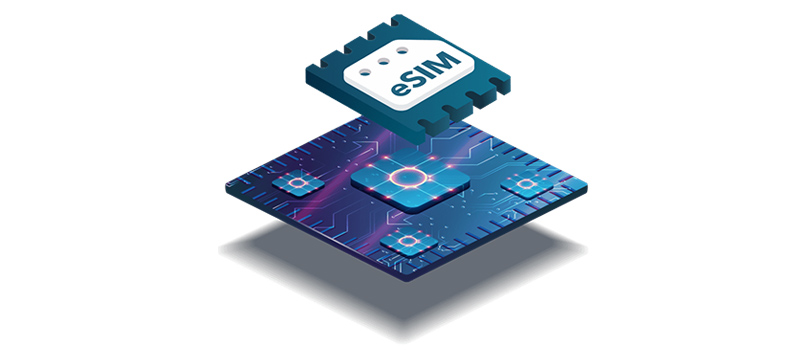By Gloria Trujillo, eSIM Group Director at GSMA, and Pablo Iacopino, Head of Research at GSMA Intelligence.
IoT is at the forefront of a new evolution, as industrial digitalisation accelerates rapidly across vertical sectors. The numbers don’t lie: almost nine in 10 (88%) enterprises already use IoT as part of their digital transformation, according to GSMA Intelligence’s recent “IoT and eSIM for digital industries” report – with automotive, utilities, and energy leading the line.
Network diversity is also expanding, tapping into IoT’s vast potential. In fact, almost three quarters (73%) of enterprises plan on using 5G networks to deploy IoT. eSIM and iSIM technologies are the primary drivers and will account for over 75% of cellular IoT connections by 2030.
As eSIM capabilities mature over the next five years, its role in enabling integrated and scalable IoT solutions will also accelerate. Industries like manufacturing, healthcare, media, agriculture, and the public sector will continue to prioritise advanced security capabilities. Meanwhile, utilities, energy, and financial services are expected to focus more on the logistical advantages and cost efficiencies that eSIM offers.
The eSIM Business Case Enhanced Scalability and Savings
eSIM has become a strategic enabler for secure, seamless, and future-ready deployments within enterprises’ digital transformation strategy. The technology not only provides global scalability, operational agility, and robust security, but also enables more cost-efficient implementation and scalable models.
What’s more, eSIM offers financial benefits that go far beyond initial cost savings. Through remote provisioning, it removes the need for physical SIM handling – eliminating storage, shipping, and manual installation. This is especially valuable for enterprises managing thousands of devices across regions, where traditional SIMs would become a logistical and financial burden.
Global deployment without manual intervention is now essential. Organisations can remotely activate and manage connectivity across borders and regulatory environments. The automotive sector illustrates this well, enabling car manufacturers to roll out connected services worldwide without tailoring solutions for each market. eSIM also brings greater flexibility. Enterprises are no longer tied to a single network provider. With seamless switching and multi-operator support, they can optimise connectivity based on performance, cost, or coverage.
As enterprises continue to scale their IoT deployments globally, having a scalable and agile solution enabled by eSIM allows businesses to streamline connectivity management, reduce operational complexity, and accelerate time-to-market. However, every stage of growth raises a critical question: how do businesses embrace innovation while maintaining a strong security posture?
Strengthened Security
Fortunately, eSIMs can offer robust security features including secure remote provisioning, manufacturing site security as well as hardware and software resistance – crucial for sectors such as healthcare and finance where privacy and data integrity are critical.
Unlike traditional SIM cards, eSIM enables remote security management, allowing enterprises to deploy over-the-air security updates without manual intervention. This feature is particularly important for rapid threat response that eliminates all the logistical nightmares related to traditional SIM cards. On a hardware and software level, the mandatory certification required for eSIM provides protection and assurance , making it particularly valuable for high-value sectors like automotive, healthcare, and critical infrastructure.
This software security foundation has been further validated through the GSMA’s recent achievement of Common Criteria EAL4+ certification, accomplished through a rigorous partnership with Germany’s Federal Office of Information Security and Deutsche Telekom Security GmbH.
The certification carries significant weight through Common Criteria’s global recognition via the Common Criteria Recognition Arrangement, enabling manufacturers to sell certified products internationally with certificates recognised across multiple jurisdictions.
The framework’s connection to the EU Cybersecurity Certification Framework further strengthens its value for enterprises operating across European markets, providing a unified approach to security certification.
Standardisation Solution for Global IoT Enablement
Enabling global connectivity without the need for region-specific SIM cards is a transformative advantage for multinational IoT deployments – such as international fleet management and global asset tracking. The adoption of eSIM technology unlocks a wide range of opportunities for enterprises embracing IoT. However, to fully realise its potential – particularly in terms of global compatibility and enhanced security – organisations must adopt a unified, standardised approach.
The GSMA plays a critical role in connecting all industry players together to develop common specifications. For example, our Protection Profile covers specifications like SGP.22 and SGP.32. Furthermore, GSMA has developed IoT Security Guidelines, and IoT Device Connection Efficiency Guidelines which help us shape a secure, scalable, and interoperable IoT market.
SGP.32 serves as the foundation for its IoT implementation, enabling fit for purpose, more secure, and compatible integration across diverse network environments.
The IoT Security Guidelines provide a comprehensive security framework that addresses the complex threat landscape facing connected devices.
IoT Device Connection Efficiency Guidelines optimise performance to ensure reliable, efficient communication between devices and networks.
The regulatory landscape is equally streamlined through established certification pathways. The potential pathway between GSMA’s eSA scheme and EUCC certification simplifies regulatory compliance across multiple markets, allowing enterprises to navigate complex jurisdictional requirements through established security frameworks.
Although it’s a relatively recent achievement, it’s already backed by real-world use cases from leading IoT and eSIM companies. G+D, a global pioneer in eSIM technology, became the first company to receive GSMA eSA scheme and eSIM Compliance programme certification for its IoT eUICC product – achieving this milestone in less than two months.
Together, these frameworks create a cohesive ecosystem where technical excellence meets regulatory compliance, enabling enterprises to deploy IoT and eSIM solutions confidently across global markets while maintaining the security and interoperability standards that modern connected infrastructure demands.
Futureproofing Through Standardisation
To make eSIM’s vast potential a reality, the industry must continue on the path of established and standardised frameworks that enable both innovation and security.
Standardised connectivity is fundamentally reshaping enterprise IoT strategy from a fragmented, region-by-region challenge into a unified global opportunity for sustained competitive advantage.
The post The eSIM Advantage: How Standardised Connectivity Is Reshaping Enterprise IoT Strategy appeared first on IoT Business News.
